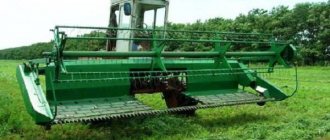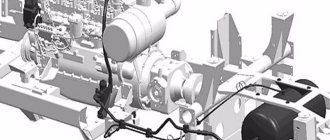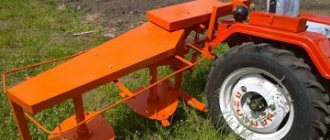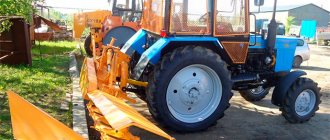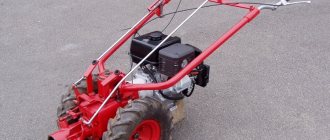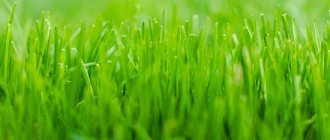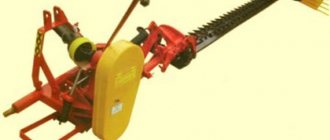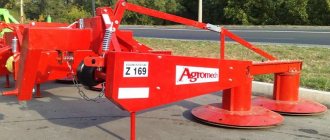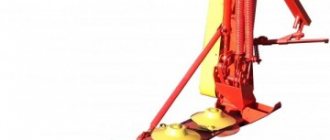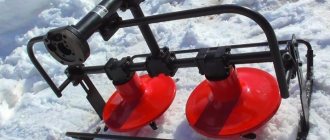During the times of the USSR, in agriculture, bets were placed equally on both agriculture and livestock breeding. And since livestock farming was highly developed, every year the livestock complex required the preparation of feed for the entire winter period. Feeds for cattle complexes typically consisted of silage, haylage and hay.
Mower conditioner Fortschritt E-303
A variety of techniques were used to prepare each type of feed. Special combines were used for silage and haylage, and mowers were mainly used for hay. Moreover, such units as mowers were of two types: trailed and mounted, mounted with tractors, and self-propelled mowers.
There weren't that many self-propelled mowers, but they were still produced. Especially valued on farms were Fortschritt E303 mower-conditioners made in the GDR. These German mowers were mainly supplied to Soviet countries. But after the unification of the GDR with the Federal Republic of Germany, the Fortschritt brand gradually disappeared, unable to compete with Western brands. But Fortschritt products, in particular the E303 mower-conditioners, continue to work today.
Advantages and disadvantages
The Fortschritt E303 mower conditioner was intended for mowing hard-stemmed crops and then flattening the stem for faster drying of the hay and knocking down the mown grass from the windrow. In addition, this self-propelled unit could be used for mowing grain crops to the “dump” during separate harvesting.
The advantages of Fortschritt E-303 were enough:
- The powerful power plant made it possible to use reapers and mowers with a wide grip on the E303;
- Replaceable working units made it possible to use this self-propelled device to perform several types of work;
- Structurally, the Fortschritt E303 was not a complicated device, which ensured reliability and easy maintainability;
- In addition to the self-propelled chassis and header, the design of the E303 also included several types of windrowers that made it possible to form swaths of cut crops to meet specific requirements.
Among the disadvantages of the self-propelled mower E 303, one can note the strictly defined applicability of this device, in addition to the fact that it was not possible to use the E303 for mowing grass and crops.
Reviews
Alexander
A mower with such technical characteristics is simply a godsend for a large agricultural farm. We have one Fortschritt E-302 mower, and it does an excellent job of cutting grass for hay and haylage on an area of 60-700 hectares. After mowing, a very powerful windrow remains, which takes a long time to dry, but for haylage this is what you need. For us, the disadvantage is that the unit works 1 month a year, and the rest of the time is idle.
Viktor Sergeevich
Our farm raises livestock and therefore constantly needs feed. We have areas allocated for alfalfa and other forage grasses, which need to be mowed accordingly. Despite the fact that we purchased a fairly used mower, after minor repairs it continues to work properly and quite efficiently. We bought the equipment quite inexpensively, and there are no problems with spare parts.
Nikolai
Some forums are dissatisfied with the E-302, they say it breaks down often and does not work as well as we would like. I will say one thing - if you properly look after the equipment, carry out technical inspections on time and eliminate minor faults, then this mower will be able to work for a long time, despite its venerable age. We have a 1992 unit and we are happy with its performance.
Device
The E303 mower conditioner structurally consisted of several main elements, each of which had its own designation. Thus, the self-propelled chassis was designated E307. The chassis had a rear-engine layout. Initially, the E307 was equipped with IFA 6VD power units. Later, the self-propelled chassis began to be equipped with the D-242 power plant.
The E307 used a variator as a transmission. The drive was carried out on only one axle, the front one, and the self-propelled chassis was controlled using the rear axle.
All controls of the E307 were located in a sealed cabin with a large glass area. There was only one door to access the cabin. Comfort for the driver was ensured only by an adjustable seat and a cabin ventilation system.
E-303 mower diagram
Types of mowing equipment
Based on the principle of operation, existing grass mowing equipment can be divided into two main types: disc and segment.
One of the most common types of grass cutting equipment is a rotary mower. Equipment of a similar principle of operation is actively used in the agricultural sector for mowing grass, preparing soil and harvesting crops, as well as in lawn mowers. The operating principle of rotary machines comes down to the fact that mowing is carried out due to the movement of disks, which are equipped with sharp blades. You can buy a rotary mower for any area at AtxTop.
Mowing equipment based on the segment operating principle has a more complex design. Equipped with two metal bars and knives between them. Thanks to this, segment equipment performs bevel. The segment mower can be used both in areas with a flat surface and in areas with complex terrain.
You can buy segment or rotary equipment by contacting us. At the same time, you will not have to doubt the quality and reliability of the purchased products, since we work only with reliable suppliers and guarantee the quality of the products sold.
Features of operation
When harvesting hay from hard-stem crops, a conditioner could be placed in the front part of the self-propelled chassis. The conditioner itself consisted of two drums interlocking through straight ribs located on them.
Since the thickness of the layer of grass supplied to the conditioner can be different, the pressure between the drums is adjusted using an installed tension spring.
For mowing grass and then flattening it, a fingerless segment header with an installed auger was used to feed the cut grass to the conditioner. Since the process of mowing with further flattening by this unit is carried out on different grasses, two headers were offered, with different working widths - E023 and E025.
Also, to work with grasses and herbaceous crops on the Fortschritt E303, two fingerless segment headers were used for soft grasses, where the use of a conditioner was not required. One of these headers is the E31B. A special feature of this header was a one-sided auger that forms a swath of grass to the left of the unit. The use of this header allowed only one swath of grass out of two passes of the mower.
The second harvester for soft grasses was designated E701. It had a double-sided auger that knocked down the windrow in the center of the header and then brought it out under the self-propelled chassis.
It was also possible to equip the self-propelled chassis with a rotary mower with the index “721”, with 4 mowing rotors.
To mow grain crops for dumping, a separate header was used - E309, also segmented and fingerless. Additionally, this header was equipped with a reel, and instead of an auger, belt feeders were used, feeding the cut crop to the center of the header with further removal of the formed windrow.
The last working unit installed on the E303 was a rapeseed header with the number designation 4712. Its design was identical to the E309 header, but its working width was smaller.
Photo of mower E-303
All mounted working units were driven by one or two power take-off shafts.
The main condition for the long-term operation of the Fortschritt E303 mower-conditioner was full compliance with the rules of maintenance and operation. Also, you should not use headers that are not designed to work with a particular crop. And the correct installation and fastening of the working elements on the self-propelled chassis was also important.
Equipment for bevelling on personal plots
Today, there is a wide selection of mowing machines of various types that will help ensure proper care of the lawn in the garden. These include:
- rotary mowers for walk-behind tractors:
- separate equipment for tall grass and uneven surfaces.
Any type, for a walk-behind tractor or independent equipment, may have different technical characteristics, depending on the specific model. The most popular among owners of personal plots is a mower for tall grass and uneven areas. Unlike the one used for the walk-behind tractor, this option runs on both electricity and a gasoline engine and has different performance.
The design of the electric mower includes blades, a deck, a grass catcher, wheels, and a starting system. This type of equipment has several key features that distinguish it from analogues and those used for walk-behind tractors, and is also excellent for tall plantings and uneven areas.
The benefits include the following:
- The equipment has a very low noise level, which allows you to mow tall grass and uneven surfaces almost silently.
- This type of bevel technique is lightweight.
- A high level of maneuverability is also characteristic of these machines, which is extremely important when mowing tall grass and uneven surfaces.
As for rotary machines for walk-behind tractors, this equipment is very similar to machines for tall grass and uneven areas, it is varied, and is selected depending on the specific model. The cutting mechanism is started by the movements of the chassis. A rotary mower for a walk-behind tractor is usually equipped with a support wheel and several discs with blades.
If you are interested in a mower for a walk-behind tractor, we recommend basing your choice of this equipment on the following basic characteristics:
- height of grass that can be mowed;
- area processed per day;
- the frequency at which the knives on the disk rotate.
You can buy equipment of any type, rotary for walk-behind tractors or tall grass, uneven surfaces, from AtxTop at very attractive prices. Along with this, you can buy equipment from us to carry out various works on your site. For example, get acquainted with the catalog of potato diggers for walk-behind tractors by following this link. Also, a large assortment of potato planters is presented here.
Specifications
Technical characteristics of the E-303 mower conditioner are given in the table:
| Characteristics | Unit measurements | IFA 6VD | D-242 |
| Engine | type | 6-cylinder in-line | 4-cylinder row |
| Power | hp | 96 | 62 |
| Transmission | type | CVT | |
| Number of gears (forward/backward) | PC. | 2/1 | |
| Speed (transport/working) | km/h | 21,4/8,6 | |
| Clearance under steering axle | mm | 750 | |
| Conditioner working width | mm | 1800 | |
| Header working width: | |||
| E023B | mm | 4270 | |
| E025B | mm | 5100 | |
| E31B | mm | 3000 | |
| E701 | mm | 4200 | |
| 721 | mm | 3000 | |
| E309 | mm | 5670 | |
| 4712 | mm | 4110 | |
| Width of formed roll (min/max) | mm | 1800/3500 | |
The video shows the E-303 mower in action:
Principle of operation
The process of turning a mass of standing plants into rows of neat windrows of already pressed crops using the E-302 mower-conditioner occurs in several stages:
- Immediately after putting the device into operation, when moving forward, the reel moves the plant stems close to the cutting tool.
- The rotor with knives, moving at very high speed, cuts the plant mass supported by the reel, which is then directed further - closer to the transport auger.
- The entire cutting volume moves to the middle part of the header, where the neck of the conditioner is located.
- The flattened stems go to the windrower, which narrows the plant flow to the required width and places it in windrows.
